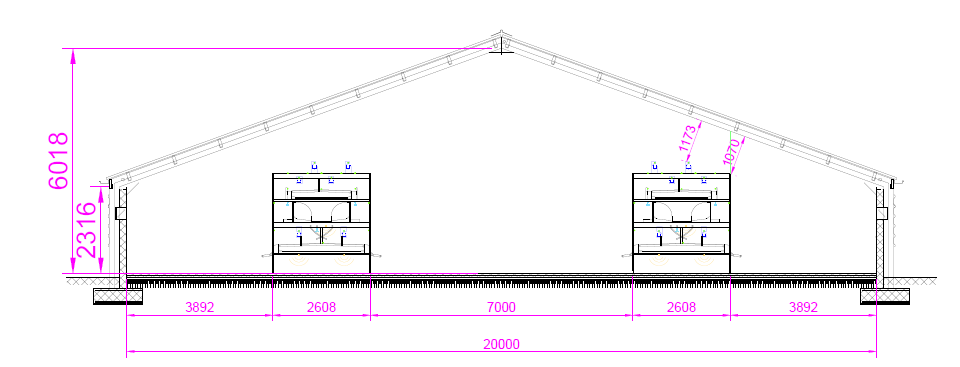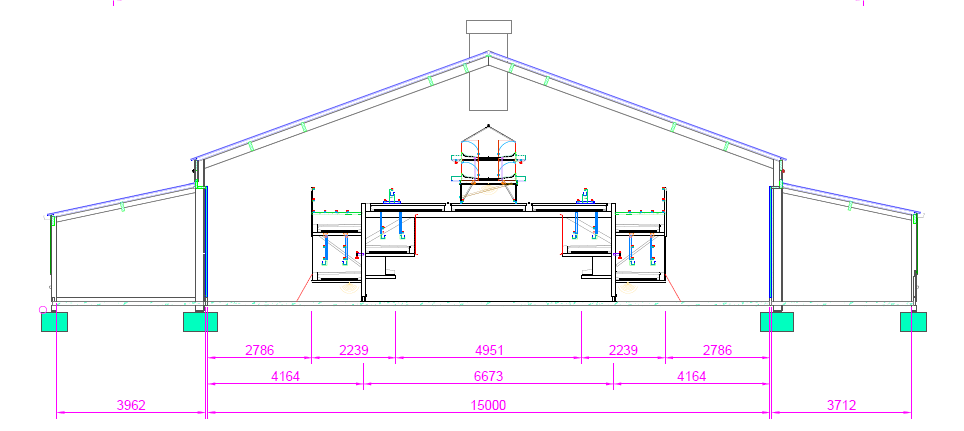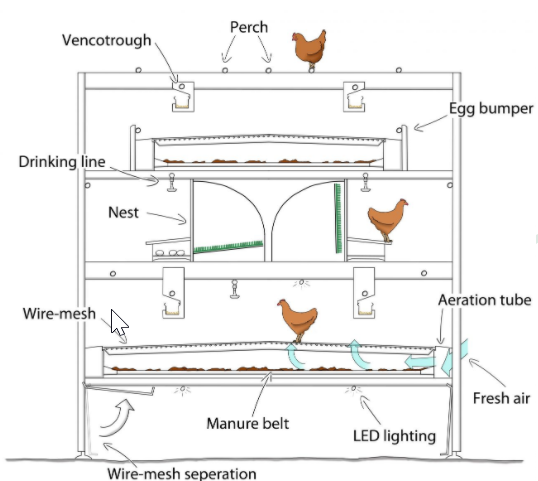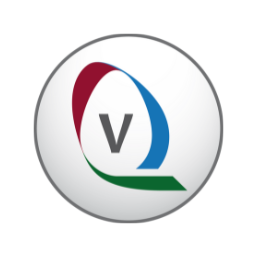Choosing an aviary system
In the previous article, I informed you about the importance of the rearing to make your production period in an aviary system successful. When the birds are transferred to the production house, this house has to have a lay-out which is optimal for managing the birds.
This is chapter 3 of our 'Cage Free' booklet.
The lay-out starts with choosing an aviary system. Which system is most suitable for the house, depends on the dimensions of the house (length, width, height) and the ventilation system (for example the location off the air inlets). Aviary systems can have extra levels to house more birds, but these higher systems do not fit in all existing houses. You can choose for a single row or 2 rows depending on the width of the house.

Figure 1 Bolegg Terrace
Other factors that have to be taken into account are the presence of natural lighting or outdoor access. Daylight and outdoor access have an influence on bird movement and distribution in the house and should thus be taken into account when choosing an aviary system. Some examples can be found in Figures 1-2: Figure 1 shows a lower house with two separate rows of aviaries and Figure 2 shows a higher poultry house with outdoor access on both sides of the house.
 Figure 2 Red-L
Figure 2 Red-L
Aviary designed with the chicken in mind
Every system has his own specifications, but they all meet the needs of the chicken. With the development we took the natural behaviour of the layers in to account. In Figure 3 you see the typical daily schedule of a chicken, which is very similar to how the ancestor of the chicken (red jungle fowl) spend their day (Collias and Collias, 1967). The red jungle fowl would sleep in trees for protection against predators and our domestic chickens still prefer to sleep on high structures.
.jpg?width=906&name=Chicken%20routine%203%20(1).jpg) Figure 3 Daily routine of a chicken. Mating only applies for breeders and will not be discussed in this article.
Figure 3 Daily routine of a chicken. Mating only applies for breeders and will not be discussed in this article.
Aviary systems have many perches on top of the system, to provide enough space for all the hens to sleep on perches. When the birds sleep in the system, they will have easy access to the feed, water and nest after waking up. Another benefit is that the birds do not pollute each other when they are all positioned on the perches.
After waking up, the birds want to eat. To make this transition from the perch to the feeding troughs easy, the position of the perches are designed to be at the right distance and angle from each other and from the platforms. Laying hens have more difficulties to jump down towards a structure at an angle of 60⁰ than with smaller angles of 30⁰ or 45⁰ (Scott et al., 1997). If structures are closer together, it becomes increasingly more difficult for laying hens to manoeuvre without getting hurt.
After eating, the chickens want to drink to help with the digestion. The drinking line is positioned in front of the nest, so that hens already move in the right direction for the next activity of the day: laying an egg. When the hens are drinking and feel the need to lay an egg, it is then only a small step to the nest.
Chickens prefer a safe and dark place to lay eggs, which is given to them in the form of a nest (Stämpfli et al., 2012). The nest is always positioned in the quietest place of the aviary. Another important aspect of the nest is that it has to be easy to enter. So don’t make obstacles on the way to the nest, because then the birds find another place to lay their eggs. Eggs that are laid in other places than the nest, for example in the scratch area or in the litter, are often dirty and broken, which reduces their saleability (Appleby et al., 1988).
One of the obstacles towards the nests can be the feeding troughs. If they are positioned too close to each other or too low, the birds will have difficulty to reach the nest. This can also cause hens to sit against the feeding troughs and see this as a nesting place, resulting in an egg next to the feeding trough. And once there is one egg outside the nest, this will attract other hens to also lay their egg there. After the laying period, there is some time for fun and relaxing. The hens jump out of the system and can do some dustbathing and in some houses they can go outside for exploring or sunbathing. During this period the birds will get hungry again, so there is another period of feeding. The day then comes to an end and all birds should find their way up towards a perch to sleep on.
Every hen needs a minimal feed trough length, perch length, nest space and drinking space. Regulations on minimal requirements differ per country and the maker of the aviary keeps these requirements in mind when designing the aviary. Adhering to the requirements is not only a legal matter, but is very important for the birds’ health and welfare.
Sufficient space for eating, drinking, egg laying, dustbathing and sleeping decreases stress and aggression in the house. Research shows that aggressive behaviour and jostling (pushing against other hens) decreased with an increasing feeder space length (Sirovnik et al., 2018). Feeder space of 4 cm per hen as recommended in the USA resulted in twice the amount of aggressive interactions compared to 10 cm, which is the requirement in the European legislation. Similar results were found in a study comparing nest space per hen, where 70 cm2 of nest space per bird led to two times more pecks and threats compared to 100 cm2 of nest space per bird (Hunniford et al., 2014).
The uniformity of the flock is also dependent on feeder and drinker space, so that all birds have equal access and can grow at the same rate (Carmichael et al., 1999). Figure 4 shows that the position of all features in the aviary are at the right place to facilitate the movement of the birds from sleeping, to eating, to drinking and to lay an egg in the nest.

Figure 4 Bolegg Terrace
Other important lay-out considerations
It is important to make sure that the ventilation system does not create any draughts near the nests. In an experiment comparing nests with and without air flow inside the nest, hens were found to avoid the nest with an airflow (van den Oever et al., 2020). This is probably more important in colder climates, because an air flow of a low temperature is less comfortable than an air flow of a higher temperature. With the manure belts and the aeration tubes in the aviary, we make sure that the system stays clean and the environment in the house is as optimal as possible.
When you start with an aviary, it is important that you realize that because birds are free, they can reach anything. Layers are very curious, they like to peck on everything, for example isolation material. The aviary is robust, but make sure the rest of the house is also like this. Pay special attention to the service compartment. This is any area in front of and sometimes in the back of the house, where the hens cannot come, in which for example your electrical cabinets are located.
There is one subject that is not discussed so far, but it can make or break your results: the lighting in your house. You have to take several aspects into account. First if there is natural light from outside coming into the house, second how are the house lights positioned and third the lights inside the aviary system. The lights should be positioned in a way that there are no dark corners in the house, because these are attractive for laying eggs. The nests should always be the darkest place in the house, to make it most attractive for egg laying. If the lights are positioned in an optimal manner, you still have to know how to use the lights.
The light intensity, but also the order in which the lights are switched on and off have a massive impact on bird behaviour and performance. When it is not correct, this can lead to for example feather pecking, large amount of floor and system eggs. Remember that hens always follow the light. Next time we inform you how to manage this.
With thanks to Anne v.d. Oever for editing












.png?width=160&height=132&name=Egg%20packers%20-%20Vencomatic%20Group%20(2).png)
.png?width=160&height=132&name=Meggsius%20Select%20-%20Vencomatic%20Group%20(2).png)







.jpg?width=1110&name=Chicken%20routine%203%20(1).jpg)






